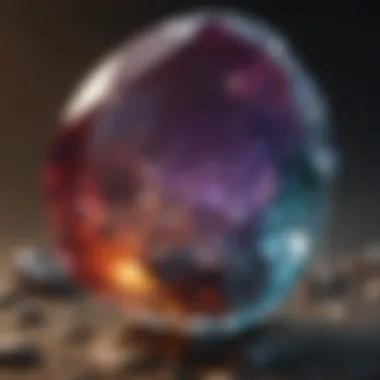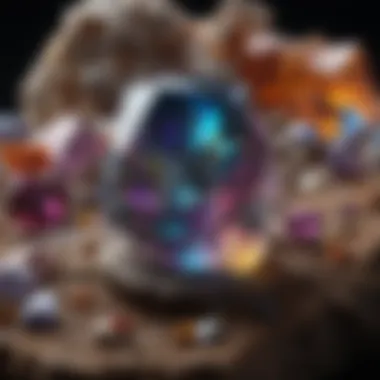A Comprehensive Guide to Identifying Gemstones by Picture for Rock and Fossil Collectors


Rock and Fossil Identification
In the realm of rock and fossil identification, one must possess a keen eye for detail and a profound understanding of the diverse types of rocks and fossils that exist. When embarking on the journey of identifying gemstones through images, it is imperative to familiarize oneself with the myriad characteristics that distinguish one specimen from another. These characteristics can range from color and luster to hardness and transparency, each providing valuable clues in the realm of gemstone identification. Moreover, the tools for identification play a crucial role in this process, allowing collectors to delve deeper into the intricate details that define each gemstone.
Collecting Tips and Techniques
For rock and fossil collectors, mastering the art of collecting goes beyond mere acquisition—it involves a delicate balance of knowledge, skill, and strategy. Best practices for collecting gemstones involve conducting thorough research, understanding the geological contexts in which they are found, and honing one's observational skills to distinguish between valuable specimens and common rocks. Additionally, locating prime collecting sites is essential for uncovering hidden gems, as different regions hold distinct geological treasures waiting to be unearthed. To ensure the integrity of specimens, knowing how to safely extract them without causing damage is paramount, preserving their beauty and scientific value for future study.
Preservation and Display
Preservation and display are integral aspects of rock and fossil collection, serving as a cornerstone for showcasing the beauty and uniqueness of each specimen. Techniques for preserving rocks and fossils vary depending on their composition and fragility, with methods ranging from protective coatings to controlled environments that prevent deterioration over time. Proper storage methods are essential to maintain the integrity of gemstones, safeguarding them from external factors that could compromise their quality. When it comes to creative display ideas, collectors have the opportunity to showcase their prized possessions in innovative and visually striking ways, captivating audiences with the diverse beauty of the natural world.
Geological Insights
Delving into geological insights offers collectors a deeper appreciation for the intricate processes that shape the Earth and give rise to fascinating rock and fossil formations. By exploring geological formations and processes, enthusiasts can unravel the mysteries of how gemstones are created, from volcanic activity to sedimentary deposition, unveiling the rich history embedded within each specimen. The historical significance of rocks and fossils provides context for their value, tracing back centuries to civilizations that revered these geological wonders for their mystical properties and practical uses. Notable discoveries in the field continue to inspire awe and curiosity, shedding light on new facets of Earth's geological past and expanding our understanding of the diverse world of gemstones.
Introduction
In the vast world of rock and fossil collection, the ability to identify gemstones through images is a skill that not only enhances one's appreciation for these natural marvels but also adds a layer of precision and expertise to the collector's repertoire. The field of gemstone identification relies heavily on visual cues, making this comprehensive guide an invaluable resource for enthusiasts seeking to deepen their understanding of gemstones through a unique lens.
This article serves as a beacon of knowledge, shedding light on the intricate details and complexities that define each gemstone. By delving into the visual realm of gemstone identification, readers embark on a journey of discovery, unraveling the mysteries held within each captivating image. Through a meticulous examination of physical characteristics, optical properties, and chemical compositions, this guide equips rock and fossil collectors with the tools necessary to distinguish one gemstone from another with confidence and clarity.
The significance of this topic lies not only in its practical implications for collectors but also in its intrinsic value as a window into the geological wonders of our planet. As readers navigate through the following sections, they will uncover the secrets of renowned gemstones like Diamond, Ruby, Sapphire, and Emerald, each unveiling its unique visual signature. By harnessing the power of images, this guide transcends conventional identification methods, offering a fresh perspective that resonates with the curious minds of rock and fossil enthusiasts. Through a seamless blend of science and artistry, readers will embark on a visual odyssey, unravelling the timeless allure of gemstones one picture at a time.
Understanding Gemstones
In this article, the focus on Understanding Gemstones is pivotal for rock and fossil collectors looking to identify gemstones by picture accurately. It provides a foundational knowledge base essential for differentiating gemstones based on physical characteristics, optical properties, and chemical composition. Understanding Gemstones allows collectors to appreciate the complexity and diversity of gemstones, enabling them to make informed decisions regarding identification and classification.
Physical Characteristics


Color
Color plays a crucial role in gemstone identification, serving as one of the primary determinants of a gemstone's value and rarity. The hue, tone, and saturation of a gemstone determine its color, with factors like impurities and trace elements influencing the final shade. In this article, delving into the specifics of color will aid collectors in recognizing and appreciating the unique color profiles of various gemstones. Understanding the significance of color facilitates accurate identification and differentiation, contributing to the overall expertise of rock and fossil collectors.
Clarity
Clarity refers to the presence of inclusions or blemishes within a gemstone, affecting its transparency and overall visual appeal. Gemstone clarity is crucial in determining the stone's quality and value, with flawless stones commanding higher prices in the market. Exploring the nuances of clarity in this article enables collectors to intently observe and assess gemstones for imperfections, supporting them in identifying and classifying gemstones accurately based on their clarity characteristics.
Cut
The cut of a gemstone influences its brilliance, fire, and overall aesthetic appeal. Different cuts, such as round, oval, or emerald, interact with light in varying ways, showcasing the gemstone's optical properties. Understanding the impact of cut on gemstone appearance equips collectors with the knowledge to differentiate between various cuts and appreciate their unique visual effects. By delving into the specifics of cut within this article, rock and fossil collectors can enhance their discernment abilities when identifying gemstones based on their cut style.
Carat Weight
Carat weight denotes the mass of a gemstone and is a significant factor in determining its value. Larger carat gemstones are typically rarer and more valuable, given their size and weight. Exploring the implications of carat weight in this article allows collectors to grasp the importance of weight measurements in gemstone identification and evaluation. Understanding how carat weight influences the overall worth of a gemstone assists collectors in making informed decisions regarding gemstone classification and assessment.
Optical Properties
Refractive Index
The refractive index of a gemstone indicates how light bends as it passes through the stone, affecting its brilliance and sparkle. Higher refractive indices result in greater light reflection, enhancing the gemstone's luminosity and visual allure. Discussing the nuances of refractive index in this article enables collectors to discern the refractive qualities of different gemstones, aiding in accurate identification and appreciation based on their refractive characteristics.
Birefringence
Birefringence refers to a gemstone's ability to split light into two separate rays, visible through a gemological polariscope. Gemstones with higher birefringence exhibit double refraction, producing distinct visual effects when viewed through the polariscope. Exploring the unique properties of birefringence within this article allows collectors to understand and identify gemstones that exhibit this optical phenomenon, enriching their knowledge and expertise in gemstone analysis.
Dispersion
Dispersion describes the spectral separation of white light into its constituent colors as it passes through a gemstone, creating fire and spectral hues. Gemstones with high dispersion showcase vibrant color flashes and spectral effects, adding to their visual appeal. Investigating the impact of dispersion in this article enables collectors to appreciate and identify gemstones with exceptional dispersive properties, enhancing their ability to recognize and differentiate gemstones based on their dispersion characteristics.
Pleochroism


Pleochroism is the phenomenon in which a gemstone exhibits different colors when viewed from different angles. Certain gemstones, like iolite and tourmaline, display pleochroic properties, showcasing an array of colors depending on the viewing angle. Examining the intricacies of pleochroism within this article facilitates collectors in identifying and appreciating gemstones with pleochroic effects, expanding their understanding of optical properties and contributing to a more comprehensive gemstone identification skill set.
Chemical Composition
Mineral Makeup
The mineral makeup of a gemstone signifies its chemical composition and crystal structure, influencing its physical and optical properties. Understanding the specific minerals present in a gemstone provides insights into its formation and characteristics. Delving into the mineral makeup within this article allows collectors to analyze and identify gemstones based on their distinct mineral compositions, aiding in the accurate classification and appreciation of gemstone varieties.
Trace Elements
Trace elements within a gemstone are impurities or additional elements present in small concentrations, contributing to its color, clarity, and overall appearance. These trace elements imbue gemstones with unique characteristics and hues, enhancing their individuality and value. Exploring the role of trace elements in gemstone composition in this article enables collectors to recognize and interpret the significance of these elements in identifying and differentiating gemstones, deepening their understanding of the chemical intricacies of gemstone formation and quality assessment.
Tools for Identification
When delving into the realm of gemstone identification, the significance of having the right tools cannot be overstated. Tools for identification play a pivotal role in discerning the authenticity and quality of gemstones, providing collectors with key insights into the gems they encounter. These tools aid in evaluating critical aspects such as color, clarity, and cut, which are essential in determining the overall value of a gemstone. By utilizing tools such as loupes, magnifiers, UV lights, and specific gravity tests, collectors can enhance their ability to accurately identify different gemstones, making informed decisions in their acquisitions.
Loupe and Magnifier
The loupe and magnifier are indispensable tools in the arsenal of a gemstone collector. These optical instruments enable collectors to closely examine the minute details of a gemstone, such as its inclusions, facets, and any imperfections that may affect its quality and value. By magnifying the gemstone's characteristics, collectors can assess its color intensity, clarity levels, and evaluate the precision of its cut. The loupe and magnifier offer a closer look at the gemstone's features, helping collectors distinguish between natural gemstones and synthetic imitations.
UV Light
In the realm of gemstone identification, UV light serves as a crucial tool in distinguishing between various gemstones. UV light testing involves examining how different gemstones react when exposed to ultraviolet light. This method helps identify specific gemstones based on their fluorescence patterns, as different gemstones exhibit unique fluorescence under UV light. By utilizing UV light testing, collectors can differentiate between gemstones that may appear similar visually but possess distinct fluorescence properties, aiding in accurate identification and authentication.
Specific Gravity Testing
Specific gravity testing is a technique employed by gemstone collectors to assess the density of gemstones in comparison to known standards. By measuring the weight of a gemstone in air and then in water, collectors can calculate its specific gravity, which is a characteristic property unique to each type of gemstone. This testing method aids collectors in confirming the identity of gemstones, as different gemstones have varying specific gravity values due to their chemical composition and structural makeup. Specific gravity testing provides collectors with valuable insights into the authenticity and composition of gemstones, assisting them in making informed judgments during the identification process.
Popular Gemstones and Their Visual Characteristics


Identifying gemstones through visual characteristics is a crucial aspect for rock and fossil collectors to differentiate between various types of gemstones. Popular gemstones like Diamond, Ruby, Sapphire, and Emerald each possess unique visual properties that aid in their identification. Understanding these visual characteristics is essential for enthusiasts in the field, as it allows them to distinguish between gemstones accurately. Diamond, known for its brilliance and fire, exhibits exceptional hardness and refractive index that sets it apart from other gemstones. Ruby, valued for its intense red color, stands out due to its strong fluorescence under UV light. Sapphire, recognized for its rich blue hues, displays excellent clarity and pleochroism that contribute to its identification. Emerald, coveted for its vibrant green color, often contains inclusions that are characteristic of this gemstone. By studying these visual characteristics closely, rock and fossil collectors can develop a keen eye for identifying gemstones accurately.
Diamond
Diamond, the most sought-after gemstone, is renowned for its unparalleled brilliance and fire. Its visual characteristics, such as colorlessness, exceptional hardness, and high refractive index, make it unique among gemstones. The absence of color in a pure diamond allows light to pass through and disperse beautifully, creating a stunning play of colors. Additionally, diamond's hardness, rated as 10 on the Mohs scale, ensures its durability and resistance to scratching - a key feature that aids in its identification. Moreover, the high refractive index of diamond results in extraordinary brilliance and sparkle, distinguishing it from other gemstones.
Ruby
Ruby, prized for its rich red color, is a gemstone that exudes luxury and elegance. Its visual characteristics, particularly its intense red hue, stem from the presence of chromium impurities within its mineral makeup. When exposed to UV light, rubies often exhibit a strong red fluorescence, further confirming their authenticity. Additionally, the clarity of a ruby, coupled with its internal characteristics like silk and rutile inclusions, serves as key identifying features for this precious gemstone. By paying attention to these visual aspects, collectors can distinguish genuine rubies from synthetic or imitation counterparts.
Sapphire
Sapphire, known for its captivating blue shades, showcases exceptional visual characteristics that make it highly desirable. Its intense color, combined with excellent clarity and pleochroism, allows sapphires to exhibit different colors when viewed from various angles. The pleochroic nature of sapphires adds depth to their appearance, showcasing a range of colors beyond the primary blue hue. Furthermore, sapphires' high refractive index contributes to their vibrant appearance and brilliance, making them stand out in jewelry and gemstone collections.
Emerald
Emerald, treasured for its lush green color, possesses distinct visual characteristics that set it apart from other gemstones. One of the most defining features of emeralds is their characteristic inclusions, known as jardin, which are often visible to the naked eye. These inclusions, formed during the gemstone's growth process, help authenticate emeralds and distinguish them from similar green gemstones. Additionally, emerald's color saturation, hue, and clarity play crucial roles in determining its quality and value. By closely examining these visual characteristics, collectors can accurately identify emeralds and appreciate their unique beauty.
Identifying Gemstones with Pictures
In the realm of rock and fossil collecting, the significance of identifying gemstones through pictures cannot be overstated. This section uncovers the pivotal role that visual representation plays in the identification process for enthusiasts in the field. By utilizing images, collectors are able to observe intricate details, colors, and structural features that may not be perceptible through naked eye observation alone. The visual medium allows for a more precise assessment of a gemstone's properties, aiding in distinguishing between different types and varieties. Rock and fossil collectors benefit immensely from this approach as it enhances their ability to make accurate identifications and expand their knowledge base. Moreover, the use of pictures provides a permanent record for comparison and reference, enabling collectors to track their discoveries and share findings with fellow enthusiasts.
Furthermore, incorporating images into the identification process offers a multi-faceted perspective that complements traditional methods such as physical and optical assessments. Visual clues captured in photographs can reveal unique characteristics that are indicative of specific gemstone species. From color variations to inclusions and growth patterns, each visual detail contributes to the comprehensive understanding of a gemstone's identity. Rock and fossil collectors can leverage this visual information to make informed decisions regarding acquisition, classification, and preservation of their specimens. Additionally, the accessibility of digital imaging technologies has revolutionized the way gemstones are documented and studied, facilitating collaborative research and knowledge exchange within the collector community.
When identifying gemstones with pictures, there are several considerations to bear in mind. Firstly, the quality of the images plays a crucial role in the accuracy of identification. Clear, high-resolution photographs taken under optimal lighting conditions yield better results than blurry or poorly lit pictures. Collectors should aim to capture multiple angles and close-up shots to capture the nuances of each gemstone effectively. Secondly, the context in which the pictures are taken is essential for establishing the gemstone's true appearance. Factors such as background color, scale reference, and accompanying documentation can provide valuable context for interpretation. Lastly, utilizing supplementary tools like magnifiers or polarizing filters can enhance the visual clarity of gemstone images, aiding in the identification process.
In essence, mastering the art of identifying gemstones with pictures opens up a world of discovery and knowledge for rock and fossil collectors. By harnessing the power of visuals, enthusiasts can unlock the mysteries hidden within each gemstone and deepen their appreciation for the natural wonders of the earth.
Conclusion
In the realm of gemstone identification, the Conclusion section serves as the paramount piece that ties together the intricate details and analyses discussed throughout this comprehensive guide. For rock and fossil collectors, discerning the key takeaways presented in this Conclusion is a vital step towards honing their skills in identifying gemstones through images. This pivotal section encapsulates the essence of the entire article, offering a summary of the essential points discussed and highlighting the practical applications of the knowledge imparted.
By delving into the various characteristics, properties, and visual indicators of gemstones, collectors gain a nuanced understanding of how to differentiate between different types of gemstones solely through visual assessment. The insights shared in this guide equip enthusiasts with the tools necessary to navigate the intricate world of gemstone identification with confidence. Moreover, the Conclusion reinforces the significance of leveraging images as a powerful resource in the field of rock and fossil collection, emphasizing the value of visual aids in augmenting one's gemological knowledge.
Furthermore, the Conclusion section sheds light on the importance of attention to detail and meticulous observation when identifying gemstones by picture. Rock and fossil collectors are encouraged to cultivate a keen eye for subtle differences in color, clarity, and other physical characteristics that play a crucial role in classification. By synthesizing the information presented throughout the guide, this section empowers collectors to refine their expertise and make informed decisions when assessing gemstones in their collections.
In essence, the Conclusion acts as a guiding beacon for rock and fossil collectors, steering them towards a deeper understanding of gemstone identification through images. It reinforces the principles explored in preceding sections, solidifying the reader's comprehension of the nuances involved in this specialized field. Through a holistic overview of the key concepts covered, this section encapsulates the essence of the guide, providing a comprehensive roadmap for enthusiasts looking to elevate their gemological expertise.







